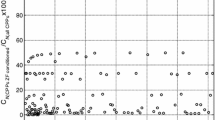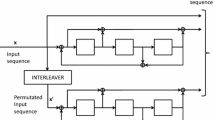Abstract
This paper presents a number of distance upper bounds for Turbo-codes designed with dithered relative prime (drp) interleavers. These bounds help determine how much dither should be applied and which input data patterns to test when designing high-distance interleavers with different lengths. Using a block length of only 640 data bits, true minimum distances of 30, 42 and 53 have been achieved for rate 1/3 Turbo-codes with 4, 8 and 16-state constituent codes, respectively. Simulated error rate results for a block length of 1504 data bits (188 bytes,mpeg packet) show excellent flare performance.
Résumé
Cet article présente un certain nombre de limites supérieures de distance pour des turbo-codes à entrelacements «réguliers à faibles variations» (dithered relative primedrp). Ces limites aident à choisir quelles petites variations doivent être appliquées et quels motifs de données d’entrée sont à tester pour définir des entrelacements permettant d’atteindre de grandes distances avec différentes tailles de blocs. Pour un bloc de 640 bits seulement, des distances minimales de 30, 42 et 53 ont pu être atteintes sur des turbocodes de rendement 1/3 à 4, 8 et 16 états respectivement. Des simulations de taux d’erreur pour des blocs de 1504 bits (188 octets, trame mpeg) montrent d’excellentes performances asymptotiques.
Similar content being viewed by others
References
Berrou (C.),Glavieux (A.),Thitimajshima (P.), Near Shannon Limit Error-Correcting Coding and Decoding: Turbo-Codes,IEEE International Conference on Commun, (ICC’93), Geneva, Switzerland, pp. 1064–1070, May 1993.
Berrou (C.),Glavieux (A.), Near Optimum Error Correcting Coding and Decoding: Turbo-Codes,IEEE Trans. on Commun.,44, no. 10, Oct. 1996.
Perez (L.), Seghers (J.), Costello D. (Jr.), A Distance Spectrum Interpretation of Turbo Codes,IEEE Trans. on Inform. Theory,42, no. 6, pp.1698–1709, Nov. 1996.
3gpp Document, 3g ts 25.212 v4.00 (2000–12), 3rd Generation Partnership Project; Technical Specification Group Radio Access Network; Multiplexing and Channel Coding (fdd).
Divsalar (D.),Pollara (F.), Multiple Turbo Codes for Deep-Space Communications,Jet Propulsion Lab. ( jpl),Pasadena,ca, tda Progress Report 42–121, May 15, 1995.
Divsalar (D.),Pollara (F.), Multiple Turbo Codes,IEEE Military Commun. Conference ( milcom’95), pp. 279–285, Nov. 6–8, 1995.
Benedetto (S.), Montorsi (G.), Unveiling Turbo Codes: Some Results on Parallel Concatenated Coding Schemes,IEEE Trans. on Inform. Theory,42, no. 2, pp.409–428, Mar. 1996.
Crozier (S.),Lodge (J.),Guinand (P.),Hunt (A.), Performance of Turbo Codes with Relative Prime and Golden Interleaving Strategies,Sixth International Mobile Satellite Conference ( imsc’99), Ottawa,on, Canada, pp. 268–275, June 16–18, 1999. (See www.crc.ca\fec.)
Hokfelt (J.),Edfors (O.),Maseng (T.), Interleaver Design for Turbo Codes Based on the Performance of Iterative Decoding,IEEE International Conference on Commun, (ICC’99), Vancouver,bc, Canada, June 6–10, 1999.
Crozier (S.), New High-Spread High-Distance Interleavers for Turbo-Codes,20th Biennial Symposium on Commun., Kingston,on, Canada, pp. 3–7, May 28–31, 2000. (See www.crc.ca\fec.)
Crozier (S.),Guinand (P.), High-Performance Low-Memory Interleaver Banks for Turbo-Codes,IEEE 54th Vehicular Technology Conference, (VTC Fall 2001), Atlantic City,nj, usa, Oct. 7–11, 2001. (See www.crc.ca\fec.)
Crozier (S.),Guinand (P.), Distance Bounds and the Design of High-Distance Interleavers for Turbo-Codes,21st Biennial Symposium on Commun., Kingston,on, Canada, pp. 10–14, June 2–5, 2002. (See www.crc.ca\fec.)
Crozier (S.),Guinand (P.), Distance Upper Bounds and True Minimum Distance Results for Turbo-Codes Designed withdrp Interleavers,International Symposium on Turbo Codes, Brest, France, pp. 169–172, Sep. 1–5, 2003. (See www.crc.ca\fec.)
Garello (R.), Pierleoni (P.), Benedetto (S.), Computing the Free Distance of Turbo Codes and Serially Concatenated Codes with Interleavers: Algorithms and Applications,IEEE Journal on Sel. Areas in Commun.,19, no.5, pp.800–812, May 2001.
Garello (R.),Chiaraluce (F.),Pierleoni (P.),Scaloni (M.),Benedetto (S.), On Error Floor and Free Distance of Turbo codes,Symposium on Commun. Theory (ICC2001), Helsinki, June 12, 2001.
Consultative Committee for Space Data Systems, Recommendations for Space Data Systems, Telemetry Channel Coding,blue book, May 1998.
Rosnes (E.),Ytrehus (O.), An Efficient Algorithm for Tailbiting Turbo Code Weight Distribution Calculation,International Symposium on Turbo Codes, Brest, France, pp.439–442, Sep. 1–5, 2003.
etsi, Digital Video Broadcasting (dvb); Interaction channel for satellite distribution systems, Nov. 2002.etsi en 301 790 v1.3.1.
Berrou (C.),Maury (E.),Gonzalez (H.), Which Minimum Hamming Distance Do We Really Need?,International Symposium on Turbo Codes, Brest, France, pp.141–148, Sep. 1–5, 2003.
Hokfelt (J.), Edfors (O.), Maseng (T.), On the Theory and Performance of Trellis Termination Methods for Turbo Codes,IEEE Journal on Sel. Areas in Commun.,19, no.5, pp. 838–847, May 2001.
Guinand (P.),Lodge (J.), Trellis Termination for Turbo Encoders,17th Biennial Symposium on Commun., Kingston, on, Canada, pp. 389–392, May 30–June 1, 1994. (See www.crc.ca\fec.)
Crozier (S.),Guinand (P.),Lodge (J.),Hunt (A.), Construction and Performance of New Tail-Biting Turbo Codes,6th International Workshop on Digital Signal Processing Techniques for Space Applications ( dsp’98),estec, Noordwijk, The Netherlands, paper 1.3, September 23–25, 1998. (See www.crc.ca\fec.)
Crozier (S.),Hunt (A.),Gracie (K.),Lodge (J.), Performance and Complexity Comparison of Block Turbo-Codes, Hyper-Codes, and Tail-Biting Convolutional Codes,19th Biennial Symposium on Commun., Kingston,on, Canada, pp. 84–88, May 31–June 3, 1998. (See www.crc.ca\fec.)
Gracie (K.),Crozier (S.),Hunt (A.),Lodge (J.), Performance of a Low-Complexity Turbo Decoder and its Implementation on a Low-Cost, 16-Bit Fixed-Pointdsp,10th International Conference on Wireless Commun. (Wireless’98), Calgary, AL, Canada, pp. 229–238, July 6–8, 1998. (See www.crc.ca\fec.)
Gracie (K.),Crozier (S.),Hunt (A.), Performance of a Low-Complexity Turbo Decoder with a Simple Early Stopping Criterion Implemented on asharc Processor,International Mobile Satellite Conference ( imsc’99), Ottawa, on, Canada, June 16–18, 1999. (See www.crc.ca\fec.)
Author information
Authors and Affiliations
Corresponding author
Additional information
This paper is an updated and extended version of [13].
Stewart Crozier received his B.Sc. degree in applied mathematics and engineering from Queen’s University, Kingston, Canada in 1979. He received his M.Eng. and Ph.D. degrees in systems engineering from Carleton University, Ottawa, Canada in 1983 and 1990 respectively. He is currently a research scientist with the Communications Research Centre, Ottawa, Canada. His primary research interests are in the fields of digital signal processing, modulation, detection and error correction coding.
Paul Guinand received his B.A. and M.Sc. degrees in mathematics from Queen’s University, Kingston, Canada in 1977 and 1979 respectively, and his Ph.D., also in mathematics, from the University of Toronto in 1987. Since 1993 he has been with the Research Communications Signal Processing group at the Communications Research Centre, Ottawa, Canada. Currently his primary research interests are in the fields of error correction coding, modulation and detection.
Rights and permissions
About this article
Cite this article
Crozier, S., Guinand, P. Distance upper bounds and true minimum distance results for turbo-codes designed with DRP interleavers. Ann. Télécommun. 60, 10–28 (2005). https://doi.org/10.1007/BF03219805
Received:
Accepted:
Issue Date:
DOI: https://doi.org/10.1007/BF03219805
Key words
- Error correcting code
- Convolutional code
- Turbo code
- Code distance
- Minimal distance
- Upper bound
- Interleaving
- Punctured code




